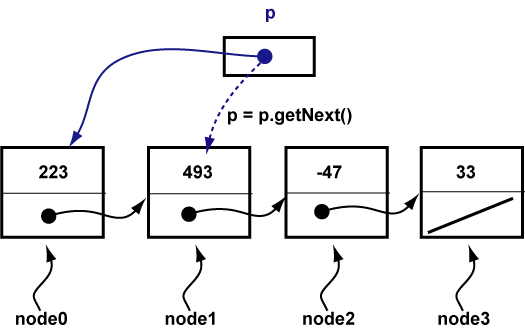p != null
The condition of the while tests if p points to a Node.
If so, the body of the loop uses that pointer.

p is advanced through the list node by node.
Soon it reaches the last node, prints it out, and
p = p.getNext()
copies a null into p.
This terminates the loop.
Here is the complete program. Compile and run it. Play with it. Make a longer linked list. (This program prints an extra comma at the end. You may wish to fix this.)
public class ChainMaker
{
public static void main ( String[] args )
{
Node node0 = new Node( 223 );
Node node1 = new Node( 493 );
Node node2 = new Node( -47 );
Node node3 = new Node( 33 );
node0.setNext( node1 );
node1.setNext( node2 );
node2.setNext( node3 );
node3.setNext( null ); // not needed. Here as a reminder.
// Traverse the Linked List in a loop
Node p = node0;
while ( p != null )
{
System.out.print( p + ", " );
p = p.getNext();
}
System.out.println( "\nEnd of List");
}
}
Here is what the program prints:
C:\JavaSource> javac Node.java ChainMaker.java C:\JavaSource> java ChainMaker 223, 493, -47, 33, End of List C:\JavaSource>
Will the program work with a list of just one Node?